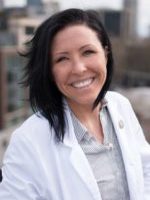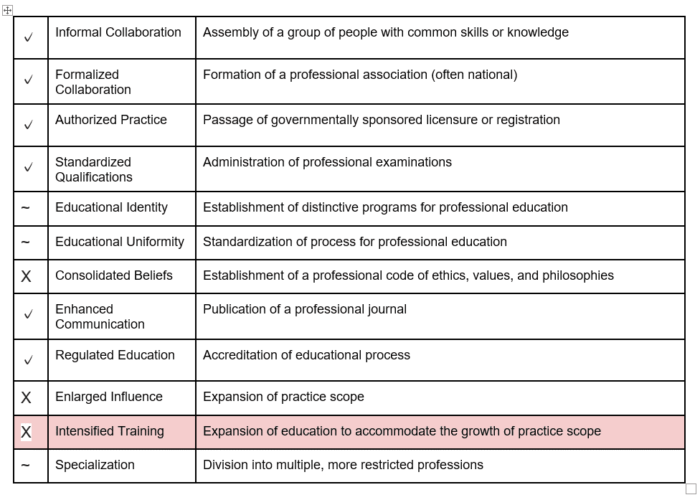By Rebekah Wilks, DC
 As doctors of chiropractic, we graduate “practice-ready,” meaning that based on our rigorous training we are qualified to immediately enter the workforce. While this designation accurately reflects our training, is this the most beneficial approach for both individual practice and as a collective unit within the evolving modern-day healthcare system?
As doctors of chiropractic, we graduate “practice-ready,” meaning that based on our rigorous training we are qualified to immediately enter the workforce. While this designation accurately reflects our training, is this the most beneficial approach for both individual practice and as a collective unit within the evolving modern-day healthcare system?
The System of Professions1, by Andrew Abbott references the steps a maturing profession must acquire for modern-day professional acceptance, which were organized by Jensen2. As you can see in the chart below, we in the chiropractic profession have completed many of these steps, yet there are several we have yet to encounter fully, including “intensified training” such as a residency program.

VA Residencies for Chiropractors Break New Ground
The chiropractic residency program in the Department of Veterans Affairs (VA) has broken new ground in this respect. As a VA resident, you graduate and begin a paid position that offers a consistent, yet complex and varied patient base. This position is guided by a team of seasoned practitioners who will initially hold your hand as you learn to navigate this new world as a doctor. They will guide you from their experiences in case management, garnering valuable patient information through integrated electronic health records, and enable you to navigate the conservative, holistic, and non-pharmacologic chiropractic approaches that are utilized nowhere else in the system.
As you delve into this new life as a doctor in the VA, you are slowly introduced into rotations through other specialties such as acute rehab, kinesiotherapy, neurology, occupational therapy, pain clinic, physical therapy, primary care and podiatry, where you gain valuable clinical pearls from other doctors and renowned professors. In these rotations, you have the ability to directly interact with other residents and practitioners while fostering professional relationships and answering questions about chiropractic. These relationships have the potential to open doors for sustainable job opportunities that will most likely offer a consistent patient base and competitive pay. Further, the communication skills acquired through a residency will enable you to more easily communicate with other practitioners throughout your career.
The VA Greater Los Angeles residency program, where I am a resident, offers the added opportunity to integrate with the Physical Medicine and Rehabilitation residents and fellows from orientation to graduation day. We retake gross anatomy—this time approaching the subject through the eyes of a clinician. Daily lectures are presented by experts in various professions, such as lab skills, MSK ultrasound, morbidity and mortality, neurology, pain, radiology, rheumatology and stroke education. Additional opportunities are provided in courses such as battlefield acupuncture, geriatrics and statistics. My medical and osteopathic resident counterparts hone their skills daily under experienced supervision, re-learning what they didn’t realize they had forgotten in school, fine tuning their professionalism and learning to navigate a full patient base with often complex comorbidities.
While conceptually I understood the value of a residency before I started my VA experience, I needed to immerse myself fully to recognize the advantages that a program like this offers, not only personally but collectivistically to the entire profession. Personally, the opportunity to learn from seasoned practitioners and through didactic courses, gain inter- and intra-professional communication skills, and acquire clinical knowledge on complex and varied cases has helped guide me through the transition from academia to new-doctor life while at the same time helping to prevent new-doctor burnout and to boost my confidence. In a future where increased work in teams is predicted in health care, communication will be paramount. Speaking the language of the existing system (e.g. residencies as a formal portion of clinical training) will enable the chiropractic profession to effectively communicate our education level while representing a consistent profession-wide reputation to patients and other practitioners.
Dr. Wilks is a chiropractic resident at the VA Greater Los Angeles Healthcare System.
References
- Abbott A. The System of Professions: An Essay on the Division of Expert Labor. Chicago, IL: The University of Chicago Press; 1988:7-17.
- Jensen, Clyde B. “The Continuum of Health Professions.” Integrative Medicine (Encinitas, Calif.), InnoVision Professional Media, June 2015, https://www.ncbi.nlm.nih.gov/pmc/articles/PMC4566463/.
